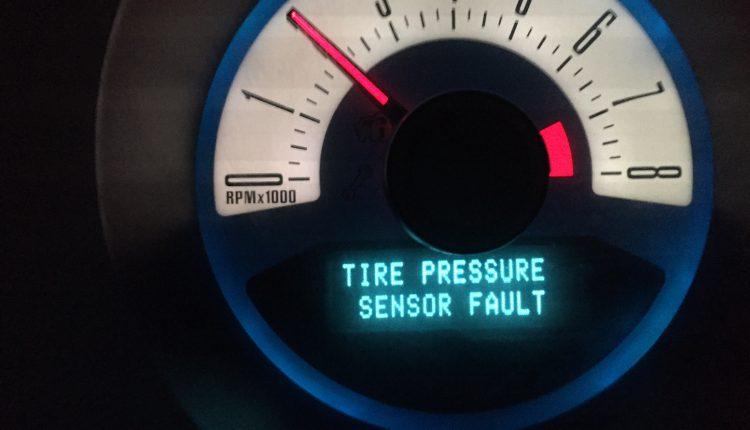How to Fix a Tire Pressure Sensor Fault
To fix a tire pressure sensor fault, check tire pressure, reset the system, or replace the sensor if needed. A tire pressure sensor fault can be resolved by following these simple steps.
Proper maintenance of tire pressure sensors is crucial to ensure your vehicle’s safety and performance. Tire pressure sensors play a vital role in alerting drivers about any potential issues with tire pressure, helping prevent accidents and damage to the vehicle.
By addressing and fixing any faults promptly, you can maintain optimal tire pressure and enhance your driving experience. Let’s delve deeper into the process of fixing a tire pressure sensor fault to keep your vehicle running smoothly and safely.

Credit: www.reddit.com
Symptoms Of A Tire Pressure Sensor Fault
When driving, having a properly functioning tire pressure sensor is crucial for the safety and performance of your vehicle. A faulty tire pressure sensor can lead to various issues and potential hazards on the road. Recognizing the symptoms of a tire pressure sensor fault is essential for prompt diagnosis and resolution, ensuring the optimal functioning of your vehicle’s tire pressure monitoring system. In this section, we will explore the key symptoms indicating a tire pressure sensor fault, enabling you to take timely corrective action.
Illuminated Tire Pressure Warning Light
If the tire pressure warning light on your vehicle’s dashboard remains constantly illuminated, it could signal a potential fault with the tire pressure sensor. This warning light typically illuminates when the system detects a discrepancy in tire pressure, indicating low pressure in one or more tires. When the sensor is faulty, it may erroneously trigger the warning light, causing confusion and potential safety concerns for the driver. Addressing this symptom promptly is crucial to ensure accurate tire pressure monitoring and safe driving.
Inconsistent Tire Pressure Readings
An additional common symptom of a tire pressure sensor fault is receiving inconsistent tire pressure readings from the monitoring system. This can manifest as fluctuating pressure values displayed on the dashboard or an inability to obtain accurate readings altogether. Such irregularities can lead to inaccuracies in assessing actual tire pressure, posing a risk of driving with underinflated or overinflated tires. Resolving this issue is imperative to maintain the accuracy of your vehicle’s tire pressure monitoring, ensuring optimal safety and performance.

Credit: www.reddit.com
Causes Of A Tire Pressure Sensor Fault
A tire pressure sensor fault can be caused by issues such as a dead battery, damaged sensor, or faulty wiring. To fix this problem, you can try resetting the sensor, replacing the battery, or consulting a professional for further assistance.
Causes of a Tire Pressure Sensor Fault
Dead or Faulty Sensor Battery
A worn-out battery can lead to sensor malfunction. Ensure regular battery replacements. Sensor Damage or CorrosionSensor Damage or Corrosion
Physical damage or corrosion can hinder sensor operation. Regular inspections are crucial. Sensor detects inadequate inflation levels, improving safety and fuel efficiency. Addressing these issues promptly prevents further damage. Remember, proper maintenance enhances sensor longevity.Diagnosing A Tire Pressure Sensor Fault
If your car’s tire pressure sensor is showing a fault, you can diagnose the issue by checking for any visible damage or corrosion on the sensor. You can also use a tire pressure gauge to manually check the tire pressure for discrepancies.
Upon identifying the fault, you can address it by replacing the sensor or performing any necessary repairs.
Checking Tire Pressure Manually
To diagnose a tire pressure sensor fault, start by manually checking each tire’s pressure. Use a tire pressure gauge to ensure the pressure matches the manufacturer’s recommendation.
Using A Tpms Scan Tool
Another option is to use a TPMS scan tool to detect any sensor malfunctions. Connect the tool to the OBD port, and scan for errors in the system.
Fixing A Tire Pressure Sensor Fault
If you’re experiencing a tire pressure sensor fault in your vehicle, it’s essential to address the issue promptly to ensure your safety on the road. Fixing a tire pressure sensor fault can help you maintain optimal tire pressure, extend the lifespan of your tires, and enhance fuel efficiency. In this guide, we’ll discuss how you can troubleshoot and resolve tire pressure sensor faults, allowing you to drive with confidence.
Replacing The Sensor Battery
When the tire pressure sensor fault is related to a low or depleted battery, replacing the sensor’s battery can often resolve the issue. Begin by identifying the sensor that requires a new battery. Using a small screwdriver, carefully remove the cover from the sensor. Take note of the battery type and carefully remove the old battery. Insert a new battery of the same type, ensuring proper orientation. Once the new battery is in place, reattach the cover and test the sensor to confirm that the fault has been resolved.
Cleaning Or Replacing The Sensor
If a tire pressure sensor fault persists after replacing the battery, it may be due to dirt, corrosion, or damage to the sensor. Begin by removing the sensor from the valve stem and inspecting it for any visible debris or corrosion. Use a gentle cleanser and a soft brush to carefully clean the sensor, removing any buildup that may be obstructing its function. If the sensor is damaged beyond repair, you may need to replace it with a new sensor that is compatible with your vehicle. Once the sensor is either cleaned or replaced, reinstall it onto the valve stem and test to ensure that the fault has been rectified.
Preventing Tire Pressure Sensor Faults
Tire pressure sensor faults can be an inconvenience and potentially hazardous if left unaddressed. However, by implementing some simple preventive measures, you can minimize the risk of encountering these issues. In this section, we will discuss two crucial aspects of preventing tire pressure sensor faults: regular tire maintenance and proper handling and storage.
Regular Tire Maintenance
Maintaining the optimal tire pressure is vital for the overall performance and longevity of your vehicle’s tire pressure sensors. Here are a few maintenance tips to keep in mind:
- Check your tire pressure regularly, ideally once a month or before long trips.
- Refer to your vehicle’s manual or the driver’s side door jamb for the recommended tire pressure.
- Invest in a reliable tire pressure gauge to ensure accurate readings.
- If the pressure is low, add air, and if it is high, release air accordingly.
- Inspect your tires for any signs of damage, such as cuts or punctures, and address them promptly.
Proper Handling And Storage
Proper handling and storage play a crucial role in preventing tire pressure sensor faults. Here are some key practices to follow:
- During tire installation or removal, avoid excessive force or rough handling, as it can damage the sensors.
- Use a torque wrench to tighten the lug nuts to the manufacturer’s specified torque settings to prevent overtightening, which can lead to sensor damage.
- When storing spare tires or seasonal tires, keep them in a cool, dry place away from direct sunlight and extreme temperatures.
- Ensure that the tires are properly inflated and periodically rotate them to prevent uneven wear and tear, which can potentially affect the sensors.
By adhering to these preventive measures, you significantly decrease the likelihood of encountering tire pressure sensor faults. Remember, regular maintenance and responsible handling are key to enjoying a smooth and trouble-free driving experience.

Credit: carfromjapan.com
Frequently Asked Questions On How To Fix A Tire Pressure Sensor Fault
How Do I Get Rid Of Tire Pressure Sensor Fault?
To eliminate tire pressure sensor fault, check tire pressure, reset sensor using vehicle’s manual, or consult a professional mechanic.
How Much Does It Cost To Fix A Tire Pressure Sensor Fault?
Repairing a tire pressure sensor fault typically costs between $50 to $200, depending on the car make and model.
Can I Fix My Own Tire Pressure Sensor?
Yes, you can fix your own tire pressure sensor by following the manufacturer’s guidelines or seeking assistance from a professional technician. Regular maintenance and proper handling are essential for the sensor’s effectiveness.
What Does It Mean When Your Car Says Tire Pressure Sensor Fault?
When your car says “tire pressure sensor fault,” it means there is a problem with the sensor that monitors the tire pressure. This could be due to a malfunction or damage, and it is important to have it checked and repaired to ensure accurate tire pressure readings and safe driving.
How Do I Know If My Tire Pressure Sensor Is Faulty?
If your tire pressure sensor is faulty, you may notice frequent low tire pressure warnings or incorrect readings on your dashboard.
What Causes A Tire Pressure Sensor Fault?
A tire pressure sensor fault can be caused by low battery power, damaged sensors, or a malfunction in the tire pressure monitoring system.
Can I Drive With A Tire Pressure Sensor Fault?
It is not recommended to drive with a tire pressure sensor fault as it may lead to inaccurate tire pressure readings and potential safety hazards.
Conclusion
Fixing a tire pressure sensor fault is an essential skill for all drivers. By following the steps outlined in this guide, you can easily diagnose and address any issues with your sensor. Regular maintenance and proper care of your tires and sensors will ensure a safer and smoother driving experience.
Always remember to prioritize safety and keep an eye on your tire pressure to avoid any potential faults.
